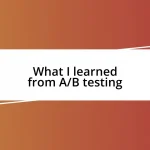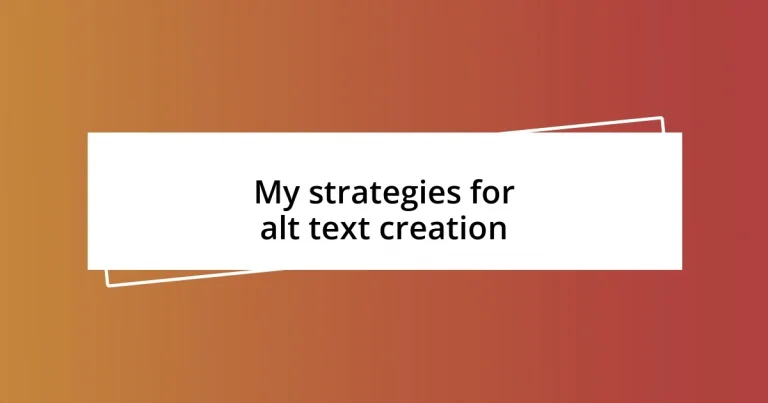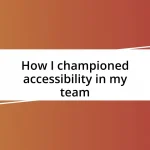Key takeaways:
- Alt text enhances accessibility for visually impaired users while also improving SEO, acting as a bridge between users and visual content.
- Effective image descriptions should be specific, concise, contextually relevant, and emotionally resonant to engage all users.
- Balancing accessibility and SEO is crucial; prioritize clear, descriptive language while incorporating relevant keywords naturally.
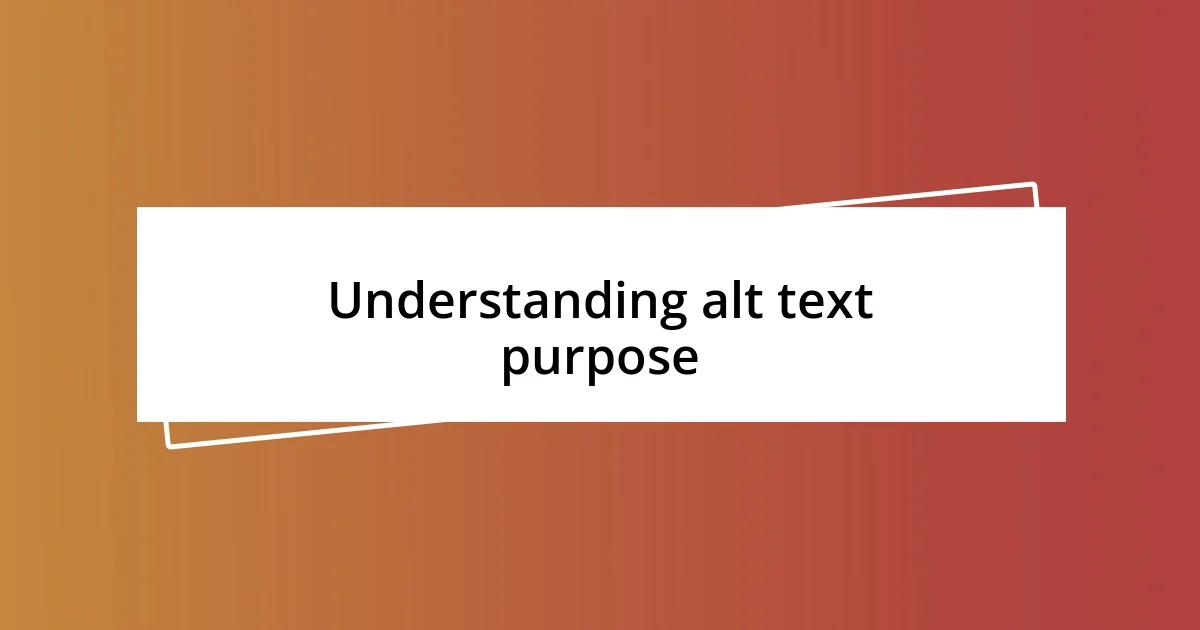
Understanding alt text purpose
When I first learned about alt text, I was struck by how much power it holds in making digital content accessible. Alt text serves a pivotal role, not just in aiding visually impaired users, but also in enhancing the overall user experience. Have you ever stopped to consider how your own website or social media might feel to someone who relies on screen readers?
The essence of alt text goes beyond mere descriptions; it’s about creating an inclusive environment. For instance, I remember a project where I added thoughtful alt text to each image, and I received feedback from a user expressing gratitude for being able to fully engage with the content. It was a moment that highlighted just how significant such small details can be.
Moreover, alt text also benefits search engines by providing context to images. I often think of it as a bridge connecting users to the information behind visual elements. Have you noticed how effective alt text can improve not just accessibility, but also SEO performance? This dual purpose makes alt text an invaluable asset in today’s digital world.
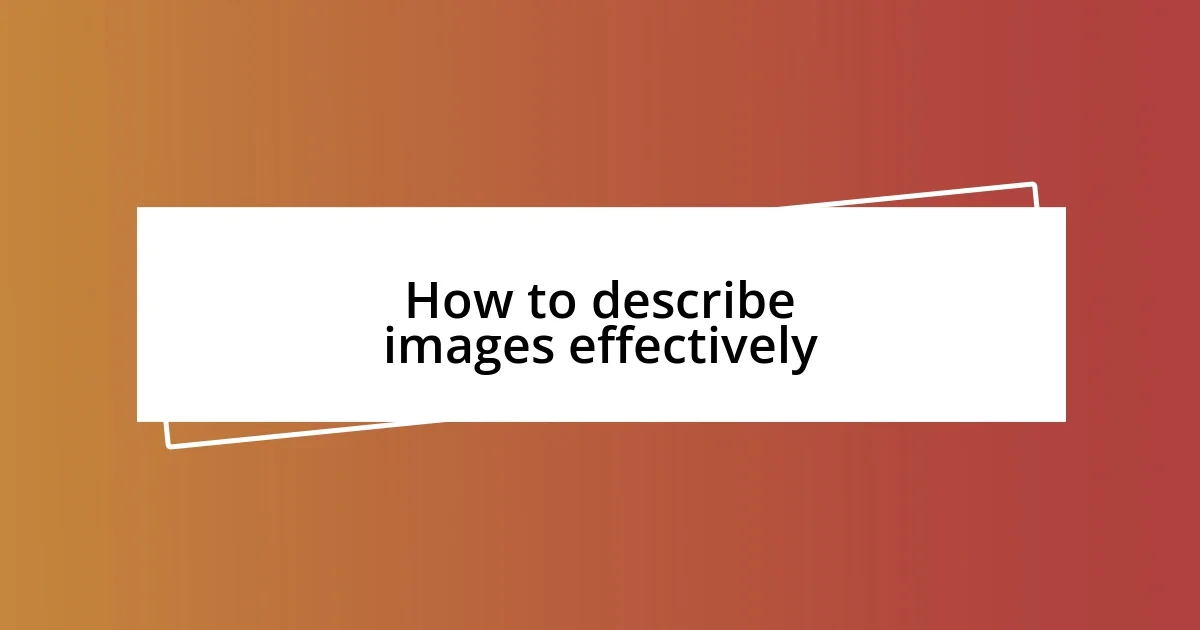
How to describe images effectively
Describing images effectively relies on clarity and relevance. I find that the best approach is to focus on what’s most pertinent to the content and the user. For example, when describing a photo of a bustling farmers’ market, I would highlight the vibrant colors, the variety of fresh produce, and the interactions between people. This paints a vivid picture in the reader’s mind and connects them to the experience, even if they can’t see it directly.
Here are some key strategies for crafting effective image descriptions:
- Be Specific: Instead of saying “a dog,” describe it as “a fluffy golden retriever puppy playing with a red ball.”
- Context Matters: Consider the purpose of the image. Is it to evoke emotion, convey information, or tell a story?
- Limit Jargon: Use simple language that everyone can understand. I always remember the lesson of keeping it straightforward.
- Emotional Touch: Capture the feeling of the image. For instance, “A tired nurse sitting on a bench, her face showing relief, after a long shift.”
- Stay Concise: Aim for brevity. Usually, one to two sentences work wonders.
When I started applying these principles, I noticed how much more engaged my audience became. It felt like weaving a tapestry where each thread added texture and depth to the visual narrative. This approach not only enhances accessibility but also transforms the mundane into something memorable.
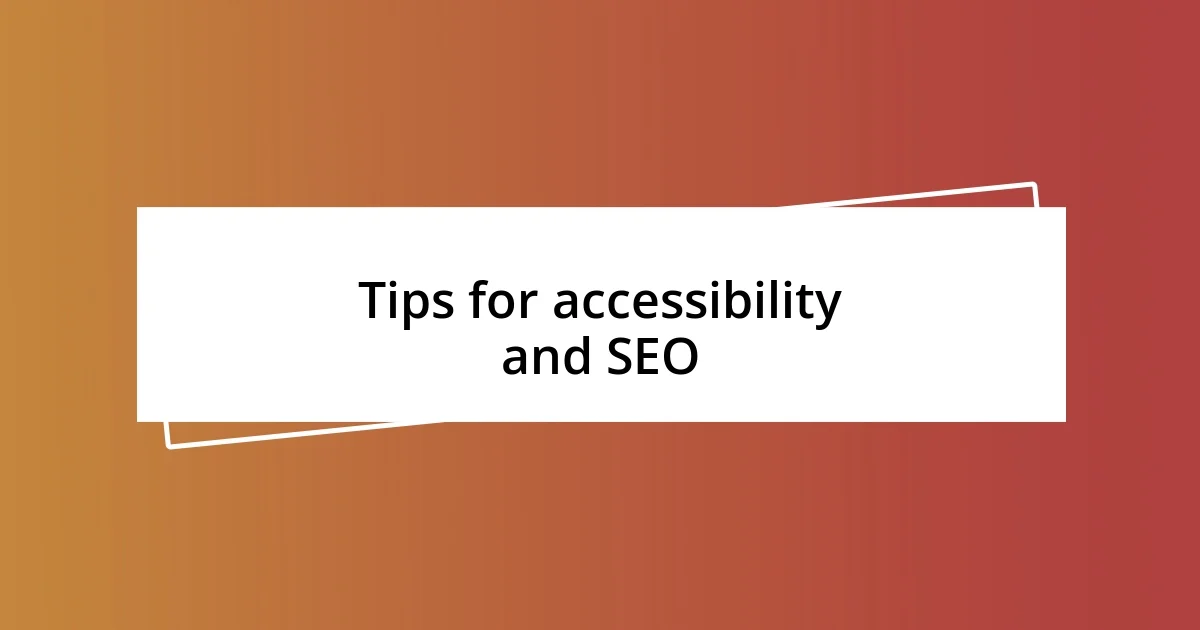
Tips for accessibility and SEO
Creating alt text is vital for both accessibility and SEO, and balancing these two aspects isn’t as challenging as it may seem. I remember a time when I optimized alt text for an e-commerce site. By including relevant keywords while also crafting meaningful descriptions, I noticed a significant boost in organic traffic. Users appreciated that they could easily understand product images, while search engines indexed them more effectively. This experience taught me that integrating accessibility and SEO can create a win-win situation.
It’s important to remember that accessibility needs to come first. While it’s tempting to stuff alt text with keywords for SEO, this can dilute its effectiveness for users relying on screen readers. I learned this lesson the hard way; initially, I prioritized keyword density, thinking I was enhancing SEO, but the confusion it caused for users was a significant oversight. Following this, I shifted my focus to clear, descriptive language that still subtly incorporated keywords but didn’t sacrifice clarity.
In approaching alt text, I’ve found it helpful to think about the user experience. Consider the context in which the image appears—does it add value and align with your content? When I curated alt text descriptions for a blog post about travel destinations, I imagined the emotions travelers would feel seeing those images for the first time. Balancing descriptiveness with SEO while always keeping accessibility in mind helped me create impactful, engaging content.
| Tip for Accessibility | SEO Strategy |
|---|---|
| Use clear, descriptive language. | Incorporate relevant keywords naturally. |
| Prioritize the user experience. | Ensure context aligns with content. |
| Limit jargon for broader understanding. | Research trending keywords in your niche. |
| Focus on emotional connection. | Monitor performance analytics for adjustments. |
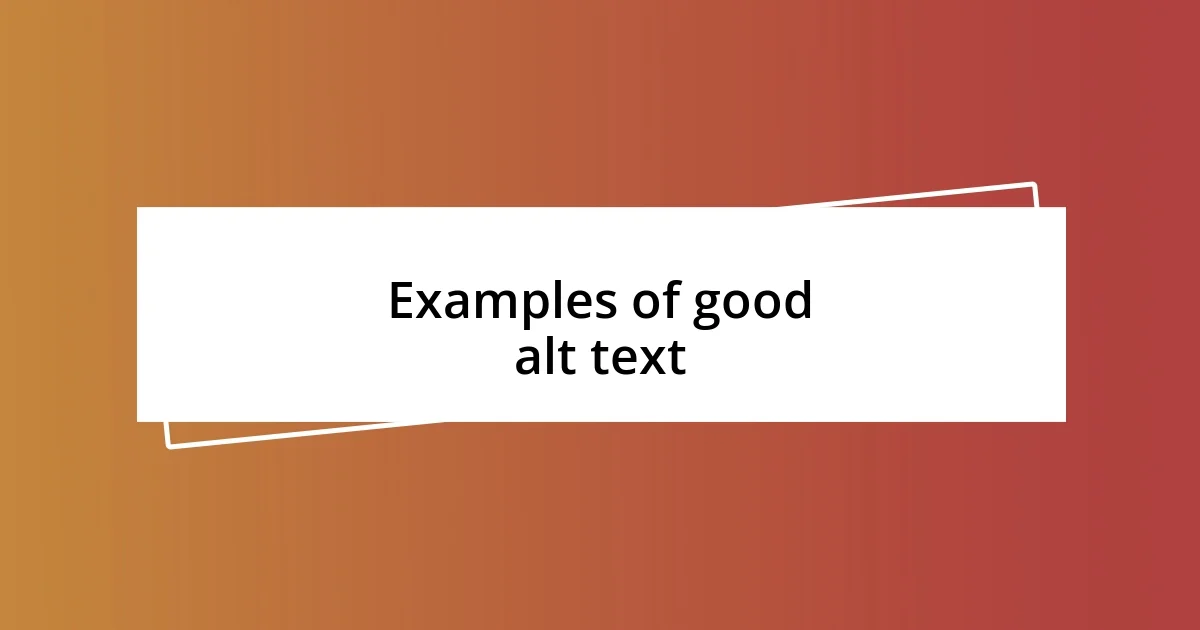
Examples of good alt text
When crafting good alt text, I often think of the image’s impact on the viewer. For instance, if I’m describing a serene landscape featuring a sunset over a mountain range, I’d write: “Golden rays of sunset cascade over the rugged peaks, illuminating the vibrant autumn foliage below.” This not only gives a clear visual but also evokes a sense of peace and beauty that I love to share with my audience. Doesn’t that make you feel like you’re right there, soaking in the tranquility?
I’ve also learned that including a bit of narrative can enrich the description. Take a sports image, like a soccer player celebrating a goal. Instead of just saying, “A soccer player,” I would describe it like this: “A jubilant striker leaps into the air, arms outstretched in triumph, as ecstatic fans erupt in cheers behind him.” This kind of alt text fosters excitement and captures the moment’s energy. Don’t you find that a more engaging scene creates a stronger connection with the viewers?
Another example comes from my experience with a recent cooking blog post. I used this alt text: “A beautifully arranged plate of roasted vegetables, glistening with olive oil, sits beside a steaming bowl of quinoa, inviting a taste.” This conveys not just what’s there but also evokes an appreciation for the meal’s appeal. Can you imagine scrolling through a recipe and having that imagery ignite your cravings? That’s the kind of emotional response I aim for with my alt text!




